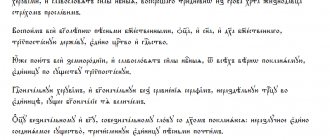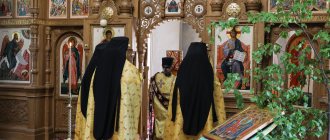A person is not always able to cope with the difficulties of life alone. There are also moments when friends and loved ones may turn away from you in a moment of grief and despondency. What to do then? Where to look for support and protection?
The Virgin Mary, having become the mother of the Son of God, became the mother of all those living today. She is always ready to accept anyone into her arms and warm them with the warmth of a loving mother’s heart. You just have to prove your faith in the Almighty. The Ave Maria prayer in Russian is just right for this.
The chant is strikingly different from all the others. It has found its place in modern secular art. The motive of Archangel Gabriel announcing the mission of Mary attracts everyone. The topic is still relevant today.
History of Prayer
Prayer takes its roots from the verses of the Gospel of Luke. They tell about the significant event of God's approval of the Virgin Mary to carry Jesus Christ in her womb. For many believers, this motive is considered fundamental, since the Lord decided to give humanity another chance by sending to earth the most precious thing - His Son.
In this episode there is joy, happiness not only for Mary, but for the whole world. As was predicted by the prophets of the Old Testament, the Son of God will come to earth and save all people.
And so it happened. The Virgin Mary, being chosen, became the mother of the Lord incarnate on earth. On this day the heavens and the earthly world rejoiced. In other words, the announcement of the Lord’s decision became the starting point of the activity of the Son of God on the path of delivering humanity from original sin.
Text of the Ave Maria prayer in Russian
Here you can read the Ave Maria prayer (text in Russian, previously in Latin). This option is specially prepared for Russian-speaking believers. The optimized text (original source - Latin) is perfect for understanding the meaning of the song and further performing it. The Russian component is conducive to this. Any language must be understandable to the reader.
Only in this case, a connection will be created between the soul of the believer and the Heavenly Kingdom. But it is difficult for a modern person to learn this prayer by heart. In this case, it is enough to carry its text with you in the inner pockets of your clothes.
RECOMMENDED: Prayer for cancer.
LiveInternetLiveInternet
Frank Cadogan Cooper. “Maiden of the Lake” Schubert decided to arrange the seven selected poems as follows: five songs for solo voice (three songs by Ellen, “Norman’s Song” and “Song of the Captive Hunter”) and two songs for vocal ensembles - “Coronach” (for women’s choir accompanied by piano) and “Song of the Boatmen” (for quartet of male voices, also with piano). So, “The Third Song of Ellen” is the famous “AVE MARIA”.
GMUNDEN Under what circumstances did Schubert create his song cycle? To answer this question, you need to mentally travel back to the summer of 1825. The small Austrian town of Gmunden, located on the northern shore of the picturesque Lake Traun, stretching exactly from north to south. Here Schubert spent six blessed weeks, during which he composed, along with other works, a cycle of songs based on the poems of Walter Scott.
GMUNDEN - PANORAMA
Little Gmunden grew noticeably in the 18th and early 19th centuries, since it became at that time an important point on the route of transporting salt from the salt mines in the southwest of it to Vienna, located in the east of it. The salt was transported across the lake to Gmunden and from there it was sent throughout the country. Later, when the reserves of salt mines dried up and industry in these places collapsed, Gmunden turned into a resort town. The families of the Habsburg dynasty loved to relax here. Gmunden also attracted romantically minded writers, musicians and artists. Lake Traun, on which it stands, is surrounded by mountains, and the shore resembles many fiords. The main mountain, called Traunstein, rises above everything. Its rocky peak is visible even from the farthest end of the lake.
TRAUNSTEIN Walking around the city with friends brought Schubert great joy.
He found these surroundings “divine.” As for Schubert's friends, he really had a lot of them. His playing attracted many music lovers to where he played music. Among these friends were: Ferdinand Traveger: Schubert stayed in his house. “I felt at home at Traveger’s and was not at all embarrassed,” wrote the composer. Johann Michael Vogl: opera and chamber singer, judging by the reviews of his contemporaries, and of Schubert himself, the first and outstanding performer of Schubert's songs. Moritz von Schwind: famous Austrian artist (he was only 21 years old that year); one of Schubert's closest friends; It was said about him - now we will consider this characterization exaggerated - that he paints pictures the same way Schubert composes music. In many of his drawings and paintings, Schwind depicted Schubert and his music playing. In one of his drawings we see a very large company - 40 (!) listeners present at the next Schubertiad (that’s what these evenings were called among friends).
MORITZ VON SCHWIND. SCHUBERTIADA. 1868
Another little-known circumstance related to Gmunden and the lake: when Schwind created a vignette for the title page of the Viennese edition of the clavier of Rossini’s opera “The Virgin of the Lake,” he depicted not some Scottish Katrina Gorge, where the action takes place in Walter Scott, but the road he has a view of Lake Traun; and these places are quite recognizable. Nanette Wolf: a beautiful young (then seventeen-year-old) pianist, the daughter of a city teacher, and, according to Schubert himself, a good singer; She was admired not only by Schubert, she won the sympathy of the poet Nikolaus Lenau. SONG TEXT The text that Schubert set to music in "Ave Maria" is a free translation from English into German, the third song of Ellen from Walter Scott's poem "The Virgin of the Lake". This translation was made by the poet Philipp Adam Storck (1780 - 1822). Thus, this particular poem by Storck should be considered the original text of the song (from the point of view of its content, a clarification can be made: - according to W. Scott). Here is this text that is absolutely organically combined with Schubert’s music: Ave Maria! Jungfrau mild, Erhöre einer Jungfrau Flehen, Aus diesem Felsen starr und wild Soll mein Gebet zu dir hinwehen. Wir schlafen sicher bis zum Morgen, Ob Menschen noch so grausam sind. O Jungfrau, sieh der Jungfrau Sorgen, O Mutter, hör ein bittend Kind! Ave Maria! Ave Maria! Unbefleckt! Wenn wir auf diesen Fels hinsinken Zum Schlaf, und uns dein Schutz bedeckt Wird weich der harte Fels uns dünken. Du lächelst, Rosendüfte wehen In dieser dumpfen Felsenkluft, O Mutter, höre Kindes Flehen, O Jungfrau, eine Jungfrau ruft! Ave Maria! Ave Maria! Reine Magd! Der Erde und der Luft Dämonen, Von deines Auges Huld verjagt, Sie können hier nicht bei uns wohnen, Wir woll'n uns still dem Schicksal beugen, Da uns dein heil'ger Trost anweht; Der Jungfrau wolle hold dich neigen, Dem Kind, das für den Vater fleht. Ave Maria!
In Russian editions of the song, A. Pleshcheev’s translation was established: Ave Maria! Before you I bow my Brow with prayer... To you, the holy intercessor, I call from the dark cliff... Human beings driven by enmity, We have found shelter for ourselves here... Oh, be touched by a sorrowful prayer And send us a peaceful sleep! Ave Maria! Ave Maria! Night has come. We are exhausted by heavy grief, And the rock above this eternal stormy sea serves as our bed. Look at us! You will drive away the ominous swarm of dreams, Shed peace into the hearts, And the night will quickly fly by... Ave Maria! Ave Maria! The evil force with you is not scary... Isn’t it you, full of goodness, the persecuted, who hid us in the mountains! And at this late hour I appeal to you with a prayer: listen! Be a holy protection for us and send us a quiet sleep! Ave Maria!
In order to have a complete understanding of what kind of literary material Schubert was dealing with, it is also necessary to cite the original text of the poem, as written by W. Scott: Ave Maria! Maiden mild! Listen to a maiden's prayer! Thou canst hear though from the wild, Thou canst save amid despair. Safe may we sleep beneath your care, Though banish'd, outcast and reviled - Maiden! hear a maiden's prayer; Mother, hear a suppliant child! Ave Maria! Ave Maria! undefiled! The flinty couch we now must share Shall seem this down of eider piled, If thy protection hover there. The murky cavern's heavy air Shall breathe of balm if thou hast smiled; Then, maiden! hear a maiden's prayer; Mother, list a suppliant child! Ave Maria! Ave Maria! stainless styled! Foul demons of the earth and air, From this their wonted haunt exiled, Shall flee before thy presence fair, We bow us to our lot of care, Beneath thy guidance reconciled; Hear for a maid a maiden's prayer, And for a father hear a child! Ave Maria! From a comparison of the German and English versions, it becomes obvious that their metrics do not always coincide. This is the reason why Schubert's plan to present the entire cycle with a bilingual text was not fully realized. "Norman's Song" in the first edition ("Matthias Artaria") was generally published only with German text. As for “Ave Maria,” its performance with the English text is very difficult, although it was published in this edition. Later editions, including Friedländer's most complete German edition, omit the English text. The incompatibility of W. Scott's original text with Schubert's music forced the publishers, in particular, when publishing the song in the American publishing house G. Schirmer" (“Fifty Six Songs You Like To Sing”), make... your own translation from German to English! Scott received his own poems back - this time as foreign ones, that is, translated from German. But the problems with the text don't end there. The very name of the song and the first address in it to the Virgin Mary - “Ave Maria” - inevitably brought to mind the Gospel text - the greeting of the Archangel Gabriel to the Virgin Mary. In the same American edition, a third version of the text is given - its Latin version. Ave Maria Gratia plena Maria, gratia plena Maria, gratia plena Ave, ave dominus Dominus tecum Benedicta tu in mulieribus Et benedictus Et benedictus fructus ventris Ventris tuae, Jesus Ave Maria Ave Maria Mater Dei Ora pro nobis peccatoribus Ora pro nobis Ora, ora pro nobis peccatoribus Nunc et in hora mortis Et in hora mortis nostrae Et in hora mortis nostrae Et in hora mortis nostrae Ave Maria It is easy to notice that the Latin text does not fit in with the rhythmic structure of Schubert’s song, and in the American edition certain fragments of it must be repeated in an illogical way. This Latin text (without repetition) is accepted in the Catholic liturgy, but is by no means the text that Schubert had in mind when he wrote this song. The German text may not be as poetic and expressive, but nevertheless it has its own charm. THE BEAUTY OF THE SONG Each verse of the song begins with a short introduction and ends with a conclusion built on the same musical material - soft-sounding rhythmically alternating ascending (to heaven?) and descending (to the sinful earth?) chords, accompanied by a measured pulsation of deep bass sounds. The music of these opening bars continues as accompaniment throughout the song. This frame is associated with an opening curtain, such as that depicted by Raphael in his famous “Sistine Madonna”. Against the background of these chords, a melody of truly unearthly beauty sounds.
COUNTESS SOPHIE GABRIEL VON WEISSEN WOLFF
Dedicating his cycle of songs to the poems of W. Scott to Countess Sophie Gabrielle von Weissenwolf (née Sophie Gabrielle Breuner), Schubert expressed his gratitude to her for her affection for him and her respect for his talent. Dates of life of the Countess: 1794 - 1847. Thus, she was three years older than Schubert and outlived him by almost 20 years. The Countess lived at Steyreck Castle, near Linz. And here, to Linz, Schubert went with Vogl from Gmunden, bringing with them new songs. Schubert came to these places for the third time, and many music lovers knew his works. Schubert was able to verify many times that they were available here - even in the monasteries of St. Florian and Kremsmunster - both in published form and in handwritten copies. As for the Countess, Schubert himself testified that “she is a great admirer of my modest talent, she has collected all my things and performs some of them very nicely. She performed Schubert's songs from his cycle "The Beautiful Miller's Wife" already in 1824, when they were first published. Thus, one of the witnesses to the Countess’s singing, Karl Haas, wrote: “The Countess seems to be gifted by nature and has a flair for art, especially for the music of Schubert... I heard her perform his “Miller’s Songs” and his other beautiful works, and she completely eclipsed with her performance Nani Hartmann (another performer of Schubert's songs from his admirers in Linz), and I am only now beginning to really understand the full meaning of Schubert's songs. You can imagine how my brother, with whom I went there, and Joseph Spaun, whom we met there, rejoiced that Schubert found such a patron in her.” THE FATE OF THE SONG Schubert’s plan to publish these songs in two languages - German and English - met with the full approval of the composer’s brother Ferdinand, who spoke on this subject: “It was high time for you to act differently when publishing your songs, but especially for me I liked your plan for publishing Walter Scott's songs, namely: publishing them along with the English text. I am already dreaming of how you will be greeted in England, how, thanks to your larger creations, for example, symphonies, oratorios and, perhaps, operas, you will reach such heights among German composers that you will become like Joseph among his brothers.” In Vienna, famous for its music publishers, a new one appeared at this time - he founded the Pennauer publishing house. Schubert, shortly before his departure to Gmunden, gave him several of his new songs and a piano sonata in A minor. The head of this publishing house sent Schubert a written proposal for cooperation, but assigned an extremely low fee. Schubert rejected this proposal. As a result, the song was published by another publishing house - the already mentioned Matthias Artaria, and paid Schubert an unprecedented fee for him - 200 guilders. Schubert himself valued the songs of this cycle very highly, especially Norman's Song. “Vogl performs it rather ponderously, but still beautifully,” Otteschwalt writes to Spaun, “for every note there is a syllable, sometimes a whole word.” But here’s what’s interesting: the extraordinary success of “Ave Maria” came as a surprise to him. Harry Goldschmit, one of the most authoritative researchers of Schubert’s work, writes, citing the composer’s own statements: “The reasons for this success made him think. “They are also surprised at my piety, which found expression in the hymn of St. Virgin Mary, which apparently affects everyone and creates a prayerful mood.” And, clearly alluding to the recipient of this letter, his own father, whose clericalism sometimes caused him resistance, he continues: “I think this happens because I never force myself to pray and never write such hymns and prayers, if I feel like it.” does not attract you involuntarily, but then my prayer becomes true prayer.” The Catholic Franz Schubert has repeatedly proven that he is alien to all church dogmatism.” Schubert's song, which aroused the delight of music lovers already at its birth, has not lost any of its popularity, but, on the contrary, over the past two centuries, has conquered millions of hearts. It was not only the vocalists who wished to have the opportunity to perform it. What kind of instruments does this wonderful melody not sound on? And the text of this song has not been subjected to any kind of processing and arrangement!
Schubert's "Ave Maria" certainly belongs to those masterpieces that capture the hearts of listeners the first time they meet them.
A. Maykapar
Questions for the priest
Is it possible to perform the Ave Maria prayer at home?
My husband really likes this composition, and he says it’s possible. I doubt it, so I decided to ask you. Of course you can. But preferably in a temple. At home you cannot create the same effect that professional singers achieve in church. Even parishioners admit that Ave Maria performed in church has a special appeal. One gets the impression of the proximity of the Kingdom of Heaven. The atmosphere created almost sets one up for direct dialogue with the Lord. Therefore, if you want your prayer to be heard, we recommend visiting a church.
I don't believe in God, but I really like the composition Ave Maria. I graduated from music school and can sing. Have a son. Can I sing Ave Maria to my son at night?
There are no restrictions on this, in fact. Today Ave Maria is considered not only the property of the church, but also of art in general. But I still recommend that you perform this work with faith in the Lord. So you will surround your son with the protection that the Mother of God protected Christ. It’s worth thinking about this if you want to not only put your child to sleep, but also surround him with care.
What is the Ave Maria prayer about? The other day, after going to church, my daughter asked who the Virgin Mary is? I couldn't give her a clear answer. I hope you can help.
It is very good that your daughter is interested in such issues. The prayer talks about such an event in the history of Christianity as the Annunciation. On the day when the Lord approved the Most Pure Virgin Mary for the birth of Christ. For every Christian this event has significance. The Son of God, spoken of in ancient prophecies, has arrived in the world. In her faith in the Lord, Mary surpassed all people, fulfilling His will. The Son of God was conceived immaculately by the Holy Spirit.
"Ave Maria" - an accidental improvisation that became a masterpiece of classical music
On May 24, 1859, Madame Caroline Miolan-Carvalho performed Charles Gounod's Ave Maria for the first time in front of a general public.
Ave Maria is the most popular Catholic prayer to the Virgin Mary, named after its initial words. This prayer is also called the angelic salutation, or angelico salutatio, since its first phrase represents the greeting the Archangel Gabriel said to Mary at the moment of the Annunciation. In the Byzantine rite, the Ave Maria prayer corresponds to the Song of the Blessed Virgin Mary. Her words were set by composers to almost 50 different melodies at different times .
Today, the hymn “Ave Maria” by Schubert is known all over the world. It seems that if you ask a person far from church life about this hymn, he will not only say that he has heard it, but will also sing the first lines. The work “Ave Maria” by Johann Sebastian Bach (1685-1750) and Charles Gounod (1818-1893) is less known in wide circles, but fascinates from the first notes. How did two great composers who lived at different times manage to become co-authors of one work?
Prelude in C major, the most famous piece from Johann Sebastian Bach's Well-Tempered Clavier, precedes a cycle of works for harpsichord consisting of 48 preludes and fugues. This clavier was written by Bach for capable young people learning music and for musical entertainment for people who own the instrument. This clavier was written by Bach back in 1722, the first part, the second part was published in 1744. And the first prelude in C major, for its sophistication and simplicity, received universal recognition from musicians of all times and peoples.
Charles Gounod, a young composer in 1852, often visited the house of Pierre Zimmermann, a famous French pianist. Gounod courted Zimmerman's daughter Anna, whom he later married. And then one day that year, while entertaining the audience in the living room, Charles, playing Bach’s Prelude in C major, decided to improvise and played a very successful addition to the already well-known prelude.
Everyone liked the improvisation very much, and the future father-in-law Zimmerman was so inspired by it that he asked Gounod to repeat it and put this improvisation on paper.
From this successful combination of Bach's prelude and Gounod's improvisation, a piece for violin or cello was formed, which was called "Reflections on Bach's Prelude in C major." Published in 1853, the play quickly became famous, it was performed in salons, sounded at the end of many concerts and was very much loved by the public. No one even thought about vocal accompaniment in the play.
After some time, Gounod based the play on the words of one of the poets of that time and it turned out that the play was excellent for performance by voice. It is unknown who proposed to superimpose the text of the prayer on these “Reflections”, but it is known that this happened 7 years after the appearance of the melody of the improvisation added to Bach’s prelude. It was in 1859 that the Ave Maria prayer was first uttered and at the same time Gounod’s opera Faust was released.
Bach's Prelude, being a completed work that does not need to be continued, when the melody of the completed composition by Gounod sounds, it becomes one with it and together they represent such a complete sound that it is impossible to guess that these two works were written by different composers, and even in such different eras.
Gounod's Ave Maria by Bach represents an integral beauty in which Bach's prelude becomes an accompaniment, and Gounod's melody leads us with some purity of sound to higher worlds and to the highest best feelings and experiences.
This is how Ave Maria Bach - Gounod found its final version, which we recognize now.
Translation of "Hail Mary!" into Russian
Hail Mary! Virgin of heaven, Lady of grace and pious mother. You accept this fervent prayer. Don't reject my lost love, Soothe her pain! My lost soul turns to you And full of hope, falls prostrate at your feet, Begs you and awaits true peace, Which only you can give. Hail Mary!
Hail Mary, full of grace, Mary, full of grace! Mary, full of grace! Rejoice, rejoice, Lord, the Lord is with you. Blessed are You among women, and blessed and blessed is the fruit of Your womb, Jesus. Hail Mary!
INVICTORY is now on Youtube, Instagram and Telegram!
Want the best content delivered straight to your favorite platforms? We prepare for you reviews of new films, interesting podcasts, breaking news and useful tips from ministers on popular platforms. Many materials are published only on them, without even getting to the site! Subscribe and be the first to receive the most interesting information!





